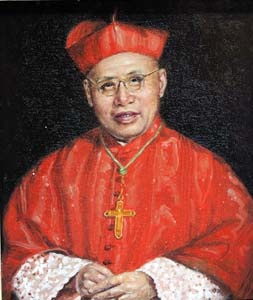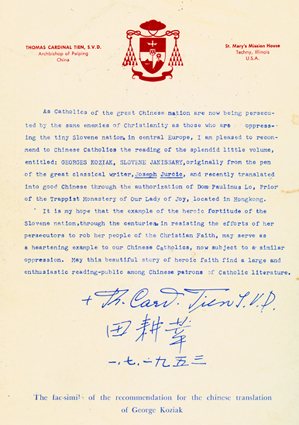Thomas Cardinal Tien, SVD
 Tien Ken-sing was born on September 27, 1890 in Chantsui, Shandong, China. His father is Tien Kailiang and mother is Maria Yang. In 1901 he was converted to Catholicism and was baptized. He attended Seminary at Yenchowfu in 1904, and was ordained to priesthood at the age of 27 on June 9, 1918 by Augustine Hemminghaus, SVD, the vicar apostolic of Yenchowfu. He later joined the SVD in March 8, 1929 in Steyl, Holland, and made his first vows in the Society of the Divine Word on February 2, 1931. Four years layer on March 7, 1935 he professed his final vows.
Tien Ken-sing was born on September 27, 1890 in Chantsui, Shandong, China. His father is Tien Kailiang and mother is Maria Yang. In 1901 he was converted to Catholicism and was baptized. He attended Seminary at Yenchowfu in 1904, and was ordained to priesthood at the age of 27 on June 9, 1918 by Augustine Hemminghaus, SVD, the vicar apostolic of Yenchowfu. He later joined the SVD in March 8, 1929 in Steyl, Holland, and made his first vows in the Society of the Divine Word on February 2, 1931. Four years layer on March 7, 1935 he professed his final vows.
After ordination, he assumed pastoral work in Yanggu mission from 1918 to 1939. On February 23, 1934 he was made Prefect Apostolic of Yanggu, and on July 11, 1939 he was appointed as Apostolic Vicar of Yanggu. Three months later on October 29, 1939, he was ordained bishop by Pope Pius XII. In 1942 he founded the sisters’ Congregation of Our Lady of China. At the age of 55, on February 18, 1946, he was elevated to cardinal. He was the first non-white and the first Chinese Cardinal. After working as Archbishop of Beijing since April 11, 1946, he was expelled from China by the Communist regime in 1951.
He participated in the conclave of 1958 which elected St. Pope John XXIII. On December 16, 1959 he was appointed by Pope John XXIII as the Apostolic Administrator of Taipei, Taiwan. Since April 1960 to December 1967 he was the Chair of Board of Trustees, Fu Jen Catholic University, Taipei, Taiwan. In 1962-1965 he attended the Second Vatican Council. In 1963 he again participated in the conclave which elected Pope Paul VI .
On July 24, 1967 at the age of 76, he died in Chiayi, Taiwan and was buried at the metropolitan cathedral in Taipei. Later he was transferred to the Cardinal Tien Memorial Chapel at the SVD mission station in Chiayi, south of Taiwan.
Total number years of service to the Church: 49 years as a priest, 27 years as a bishop, and 21 years as a cardinal.
Influence of St. Joseph Freinademetz, SVD on Thomas Cardinal Tien, SVD
(Thomas Cardinal Tien, SVD, who knew Joseph Freinademetz [first SVD missionary to China] from his childhood in Shantung, gave a brief sketch of Joseph on the fiftieth anniversary of his death:)
All (Chinese) Christians considered Joseph to be a living saint…. He was always friendly, modest, humble. He spoke Chinese well. Whoever came in contact with him was deeply impressed and somehow drew comfort from his very presence. A catechist who hardly had a good word to say about the foreign missionaries said about Joseph: 'Fu Shenfu is a saint. He is different from all the others'.
While I was a seminarian, I noticed in church how Joseph always knelt in the sanctuary. It was a powerful experience to see hi in prayer before the tabernacle. Other missionaries were no less zealous than he was, but for us Chinese, their manner was somewhat too aggressive and often too inconsiderate. This was not the case with Joseph. He was always available to others and sacrificed himself to the utmost limit of self-forgetfulness. His piety was natural and attractive. He always remained his friendly self. He was indeed a perfect man.
From an Article in Time Magazine, Monday, Feb. 29, 1960
In Rome last week for an audience with Pope John, frail, pale Thomas Cardinal Tien Ken-sin, 69, was halfway to a new assignment—his first since 1948. In that year, as the Chinese Reds were advancing against the Nationalists, Chinese Cardinal Tien, suffering from a heart ailment, left Peking for Shanghai and then for a long recuperation in the still peaceful British Crown Colony of Hong Kong.
After China fell to the Communists, the cardinal retired to a seminary of his congregation, the missionary Society of the Divine Word, near Chicago. No assignment came from Pope Pius XII, who was said to be irked that the cardinal had left his post. But John XXIII, deeply concerned over the Chinese Communists' efforts to establish a tame "national" Catholic Church in schism from Rome, felt that Cardinal Tien could serve on Formosa as a rallying point for Asian Catholicism and as a symbol of papal interest in the Far East. He installed him as apostolic administrator in Formosa, which now has 200,000 Catholics (up from 12,000 in the past ten years).
"I didn't go back before to avoid increasing the Communist persecution of the mainland priests," said Cardinal Tien last week. "But now the situation could not be worse, and perhaps my return will give the Catholics moral encouragement".
Cardinal Tien's letter while living in exile in St. Mary's Mission House, Techny, Illinois, USA
 As Catholics of the great Chinese nation are now being persecuted by the same enemies of Christianity as those who are oppressing the tiny Slovene nation, in central Europe, I am pleased to recommend to Chinese Catholics the reading of the splendid little volume, entitled: GEORGES KOZIAK, A SLOVENE JANISSARY, originally from the pen of the great classical writer, Joseph Jurcic, and recently translated into good Chinese through the authorization of Dom Paulinus Lo, Prior of the Trappist Monastery of Our Lady of Joy, located in Hongkong.
As Catholics of the great Chinese nation are now being persecuted by the same enemies of Christianity as those who are oppressing the tiny Slovene nation, in central Europe, I am pleased to recommend to Chinese Catholics the reading of the splendid little volume, entitled: GEORGES KOZIAK, A SLOVENE JANISSARY, originally from the pen of the great classical writer, Joseph Jurcic, and recently translated into good Chinese through the authorization of Dom Paulinus Lo, Prior of the Trappist Monastery of Our Lady of Joy, located in Hongkong.
It is my hope that the example of the heroic fortitude of the Slovene nation, through the centuries, is resisting the efforts of her persecutors to rob her people of the Christian Faith, may serve as a heartening example to our Chinese Catholics, now subject to a similar oppression. May this beautiful story of heroic faith find a large and enthusiastic reading-public among Chinese patrons of Catholic literature.
